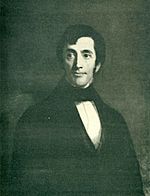John Davy (chemist) facts for kids
Quick facts for kids
John Davy
|
|
|---|---|

Portrait of John Davy
|
|
| Born | 24 May 1790 |
| Died | 24 January 1868 (aged 77) |
| Nationality | British |
| Known for | Phosgene |
| Scientific career | |
| Fields | Chemistry |
John Davy (born May 24, 1790 – died January 24, 1868) was a British doctor and chemist from Cornwall. He was the younger brother of the very famous chemist, Sir Humphry Davy. John Davy made important discoveries in chemistry and also worked as an army doctor, traveling to many different parts of the world.
Contents
Early Life and Education
John Davy was born in Penzance, Cornwall, on May 24, 1790. His parents were Robert Davy and Grace Millet.
When he was younger, John helped his older brother Humphry at the Royal Institution of Great Britain. This was a place where scientists did experiments and shared their knowledge. After two years there, John went to Edinburgh University to study medicine. He earned his medical degree in 1814.
Amazing Discoveries
While studying, John Davy made some big scientific breakthroughs.
- In 1812, he discovered a chemical compound called phosgene. He was also the one who gave it that name!
- At the same time, he figured out that chlorine was actually an element. Before this, people weren't sure.
- He also discovered another chemical compound called silicon tetrafluoride.
These discoveries showed he was a very talented chemist, just like his brother.
A Doctor's Travels
After becoming a qualified doctor in 1815, John Davy joined the British Army Medical Department. He started as an Army Hospital Assistant.
- From 1816 to 1820, he worked as a Staff Surgeon in a hospital in Brussels.
- Later, he was sent to many British colonies around the world. These included places like India and Ceylon (which is now Sri Lanka).
- In 1862, he became the Inspector General of Army Hospitals in the West Indies, based around Barbados. This was a very important job, overseeing many hospitals.
Later Life and Legacy
John Davy was recognized for his scientific work.
- In 1834, he was chosen to be a Fellow of the Royal Society. This is a very respected group of scientists.
- From 1836 to 1840, he worked on a huge project. He put together nine volumes of all the collected writings of his famous brother, Sir Humphry Davy. This helped preserve his brother's important work.
- In 1842, he also became a Fellow of the Royal Society of Edinburgh.
One interesting discovery he made later in life was about eggshells. In 1863, he found that eggshells have about 8,000 tiny holes, or pores. These pores are big enough for oxygen to get in and carbon dioxide to get out. He proved this by pumping air into an egg underwater and watching thousands of tiny bubbles appear!
John Davy eventually returned to England. He moved to the beautiful Lake District area. He passed away there on January 24, 1868, near Ambleside.
Selected Writings
John Davy wrote many articles about chemistry for Rees's Cyclopædia. He also published the collected works of his brother, Sir Humphry Davy, in nine volumes.

